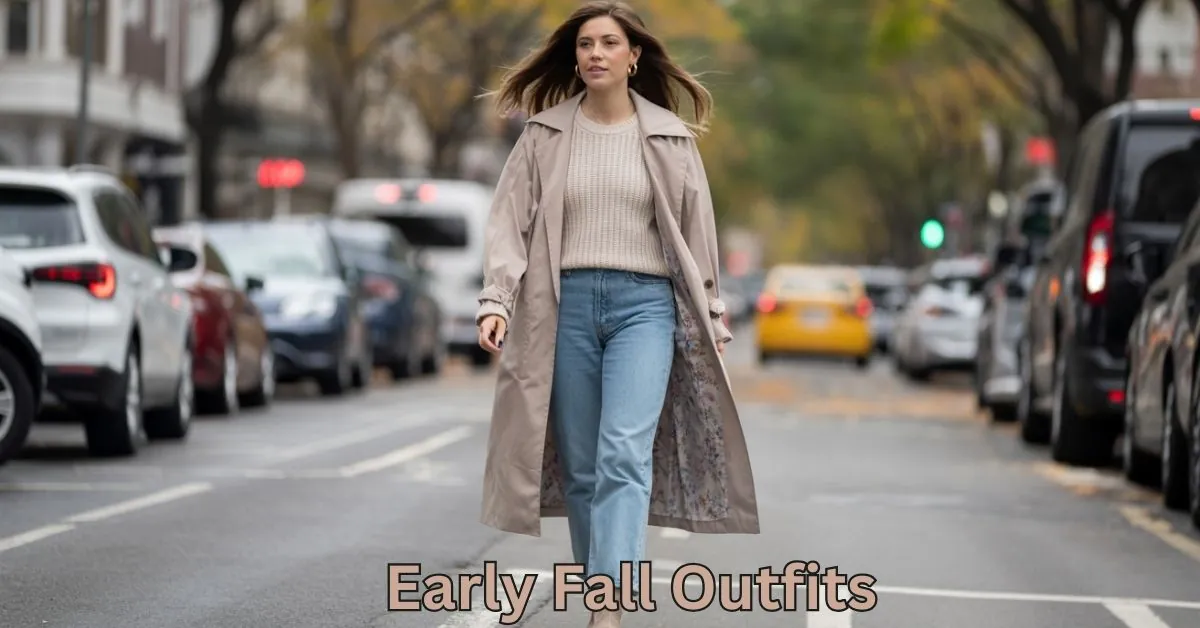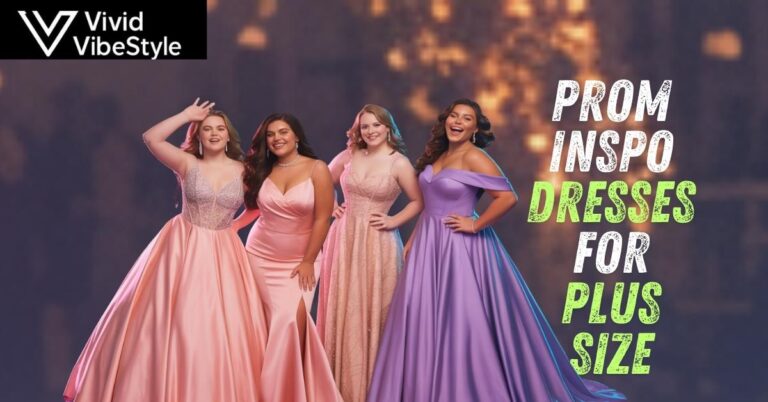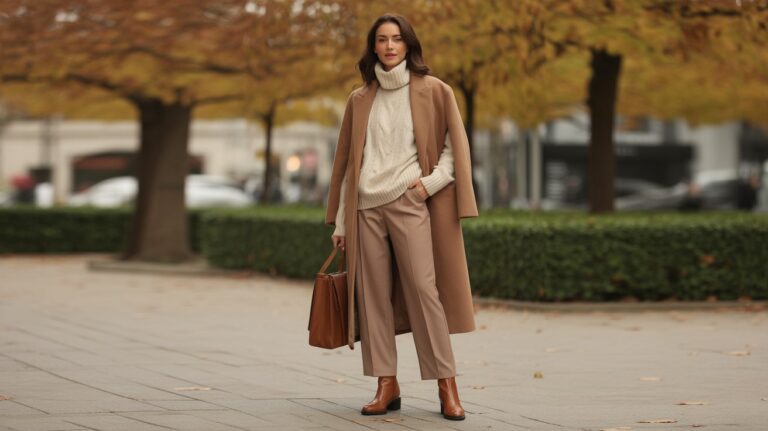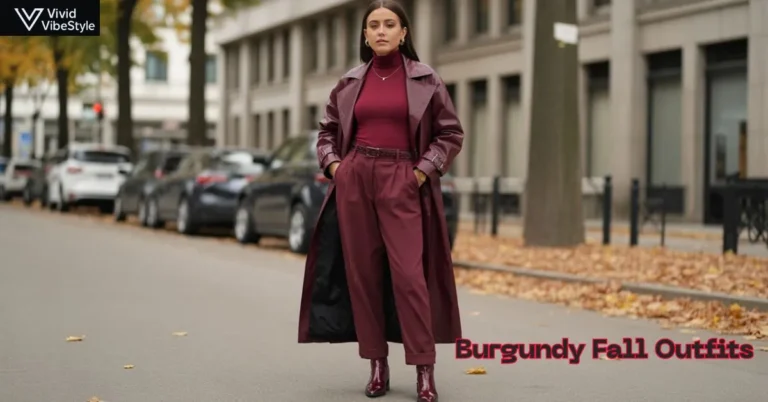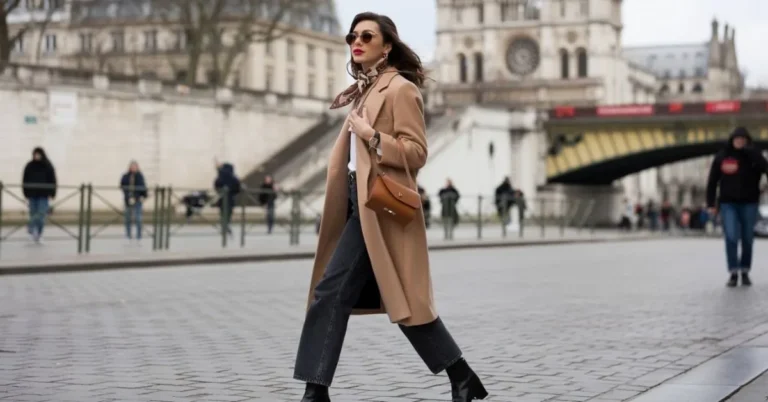Early Fall Outfits: Complete Guide to Transitional Style for 2025
You’re standing in front of your closet on a crisp September morning, staring at summer clothes that suddenly feel too light and winter pieces that seem too heavy for the unpredictable weather. The temperature forecast shows 55°F at dawn and 78°F by afternoon, a classic early fall dilemma that leaves you either shivering in the morning or sweating by lunch. Your usual go-to outfits don’t work anymore, and you’re tired of getting the temperature equation completely wrong day after day.
The truth is mastering early fall outfits isn’t about having an entirely new wardrobe—it’s about understanding how to strategically layer, mix textures, and transition your existing pieces for the season’s unpredictable weather patterns.
With the right approach to transitional dressing, you can create versatile looks that work from morning coffee runs to evening dinners, all while staying comfortable and stylish throughout those tricky temperature swings that define early autumn.
Why Early Fall Fashion Requires a Different Approach
Early fall outfits demand a completely different strategy than traditional seasonal dressing because you’re dealing with weather that can’t make up its mind. September’s “fickle weather” means “chilly mornings and sweltering afternoons,” requiring outfit formulas that adapt throughout the day rather than static looks designed for consistent temperatures.
The key to successful transitional dressing lies in understanding that “one major key to a comfortable transitional outfit is layering. You need to have something to throw on for chilly mornings and nights but be able to take off in the late afternoon sun.” This approach transforms your wardrobe from a collection of seasonal pieces into a strategic system of adaptable layers.
The Science Behind Transitional Weather Dressing
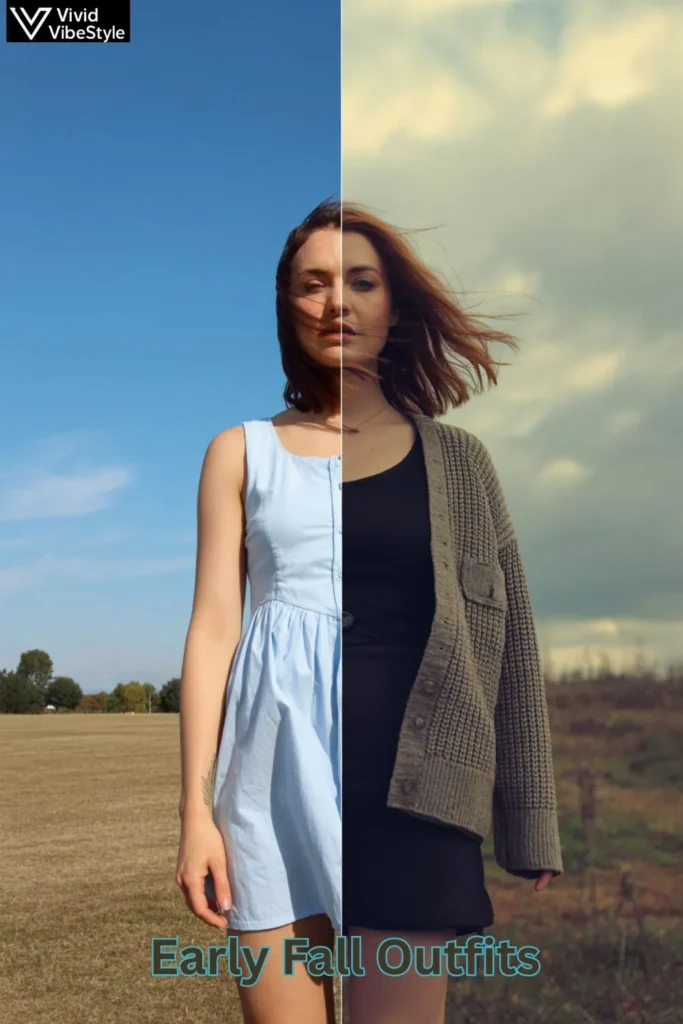
Transitional outfits work best when built around breathable fabrics that accommodate temperature fluctuations. Fashion experts recommend sticking “to breathable fabrics like cotton, bamboo and merino wool” because “this will allow you to layer comfortably” without overheating when temperatures rise unexpectedly during the day.
The psychological aspect of early fall dressing also plays a crucial role in outfit success. Your wardrobe choices signal the seasonal transition to both yourself and others, making it important to incorporate autumn-appropriate colors, textures, and silhouettes even when temperatures haven’t fully committed to fall weather patterns.
Essential Layering Strategies for Early Fall Success
Mastering layering outfits for early fall means building looks in removable components rather than single statement pieces. Start with a lightweight base like a cotton tee or silk blouse, add a middle layer such as a cardigan or blazer, and finish with an easily removable outer piece like a denim jacket or lightweight scarf that can disappear into your bag when the sun comes out.
Effective early fall layering “might involve wearing a denim or a casual lightweight jacket over a T-shirt,” incorporating “warmer fabrics like wool, denim, flannel, and heavier cotton blends” that “provide insulation against the cooler” morning temperatures while remaining comfortable throughout the day.
Read More About : Preppy Fall Outfits: Your Complete Guide to Timeless Autumn Style 2025
Strategic Layer Combinations That Actually Work
The most successful early fall outfits use the “rule of threes”—three distinct layers that can function independently or together depending on temperature needs. Think silk camisole + cotton cardigan + denim jacket, where each piece serves a specific thermal purpose while maintaining style cohesion throughout various combinations.
Professional stylists emphasize that “layering becomes essential” as weather cools, recommending adding “a long cardigan or a light jacket over your sweater for extra warmth” while ensuring that “accessories can make” significant impacts on both functionality and overall aesthetic appeal.
What Fabrics Work Best for Transitional Weather?
Fall fashion trends for transitional weather prioritize natural fibers and fabric blends that regulate temperature naturally. Cotton remains the ultimate early fall base layer because it breathes well during warm afternoons yet provides enough structure for layering when morning temperatures drop unexpectedly.
Successful transitional styling involves “lighter materials – think sheer layers or flowy tops and skirts” which “makes it easier to catch a breeze and just stay cooler in general throughout the later parts of the day.” This approach ensures comfort during temperature spikes while maintaining the visual weight appropriate for autumn.
Fabric Combinations That Regulate Temperature
Merino wool deserves special attention in early fall wardrobes because it naturally regulates body temperature, wicking moisture when you’re warm and providing insulation when temperatures drop. Unlike traditional wool, merino feels comfortable against skin and works beautifully in transitional layering systems.
Silk blends offer another excellent option for early fall outfits because they provide luxury and temperature regulation without bulk. A silk-cotton blend cardigan or blouse moves seamlessly from air-conditioned offices to sunny outdoor lunches while maintaining an elevated appearance throughout the day.
How to Style Dresses for Early Fall Weather
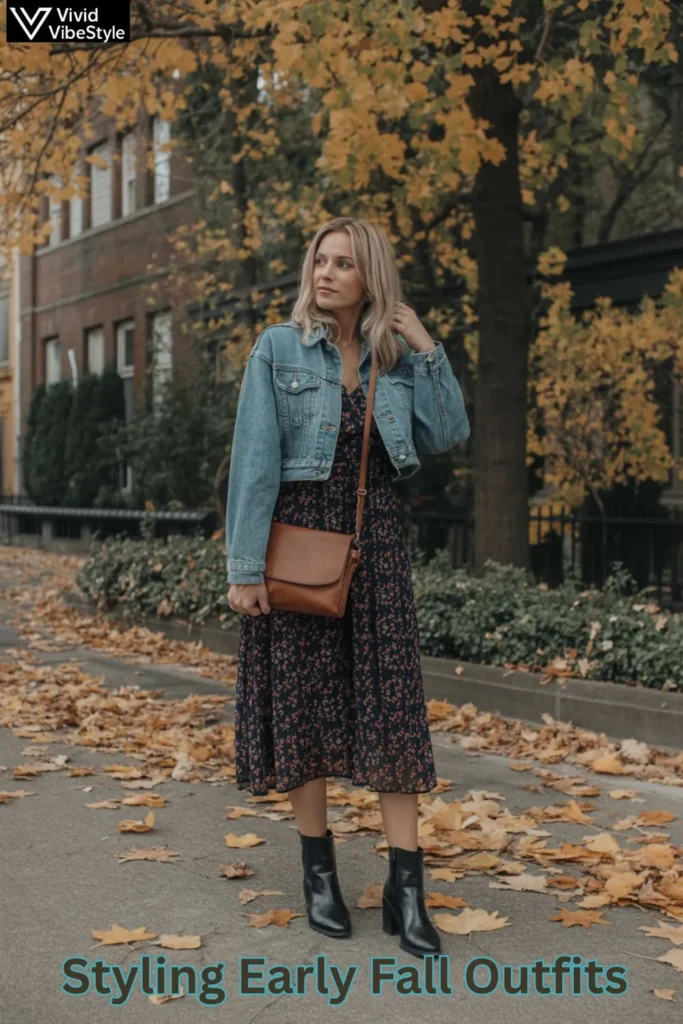
September outfits featuring dresses require strategic styling to work across varying temperatures throughout the day. “Dresses can still be worn in September” when you “opt for breathable fabrics like cotton or silk to combat the lingering late summer heat” while incorporating transitional accessories that add warmth without overwhelming the look.
The secret to successful early fall dress styling lies in choosing pieces with sleeves or adding layers that complement rather than hide the dress’s silhouette. A sleeveless midi dress works beautifully with a lightweight blazer or denim jacket, creating sophisticated looks that transition effortlessly from professional settings to casual weekend activities.
Dress Layering Techniques for Variable Temperatures
Transform summer dresses into early fall staples by adding tights, boots, and structured jackets that change the entire outfit’s seasonal appropriateness. A floral sundress becomes autumn-appropriate when paired with opaque tights, ankle boots, and a tailored blazer in a coordinating autumn shade.
Contemporary styling approaches suggest taking “a break from boots and style a sporty sneaker with a polished dress” for early fall looks that feel fresh and unexpected while remaining comfortable for day-long wear during transitional weather periods.
Read More about : Mini Uggs Outfit Ideas for 2025: Stunning & Cozy Styling Guide
What Colors Define Early Fall Style?
Autumn style in early fall balances summer’s bright optimism with fall’s rich sophistication through strategic color choices. Earth tones, deep jewel shades, and warm neutrals signal the seasonal transition while remaining light enough for warm afternoon temperatures that characterize September and early October weather patterns.
Current trends show that “leopard print, red, and metallics can be seen in the new arrivals section of every major retailer,” while “quiet luxury items” and “coastal—grandma or cowgirl—pieces can definitely still be styled for 2025.” This indicates that early fall color palettes can accommodate both bold statement pieces and subtle neutral foundations.
Seasonal Color Transition Strategies
The most successful early fall outfits incorporate colors that work in multiple lighting conditions, from morning’s soft light to afternoon’s harsh sun to evening’s golden hour. Burgundy, forest green, burnt orange, and deep navy provide richness without appearing too heavy for lingering warm weather.
Neutral bases in cream, camel, and soft gray create perfect foundations for early fall looks because they coordinate effortlessly with seasonal accent colors while remaining light enough for warm days. These shades also photograph beautifully in autumn’s changing light conditions, making them ideal for both professional and social occasions.
Are Boots Appropriate for Early Fall Outfits?
Early fall outfits can definitely include boots, but the key lies in choosing styles that won’t cause overheating during warm afternoon temperatures. Ankle boots in breathable materials like soft leather or suede provide autumn styling without the thermal commitment of tall boots or winter-weight footwear.
The transition from sandals to closed-toe shoes marks an important shift in early fall styling, but doesn’t require immediately jumping to heavy winter footwear. Low-profile boots, loafers, and stylish sneakers offer the perfect middle ground between summer sandals and winter boots while maintaining comfort across temperature fluctuations.
Footwear Strategies for Transitional Weather
Smart transitional footwear choices include “trendy open-toe clogs in place of sandals” for warmer fall days, allowing you to maintain seasonal appropriateness while accommodating higher temperatures that haven’t fully committed to autumn weather patterns.
Versatile ankle boots become the cornerstone of successful early fall wardrobes because they work with dresses, jeans, and everything in between. Choose styles in neutral colors like cognac, black, or taupe that coordinate with multiple outfits while providing the visual weight that signals seasonal transition.
How to Transition Work Outfits for Early Fall
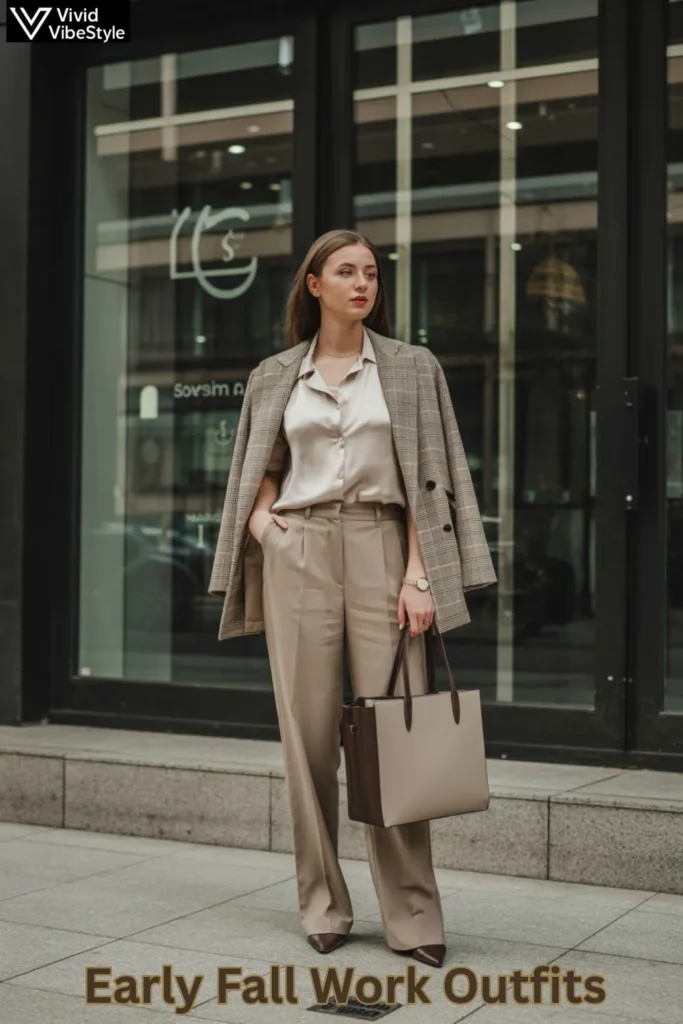
Professional early fall outfits require balancing seasonal appropriateness with workplace dress codes and varying office temperatures. “Transition your wardrobe by incorporating early fall pieces like blazers, cardigans, or lightweight sweaters. These can be added or removed depending on the temperature” while maintaining professional polish throughout the workday.
The office environment presents unique challenges for transitional dressing because indoor temperatures often differ dramatically from outdoor conditions. Building work outfits around removable layers ensures you remain comfortable and professional regardless of air conditioning settings or outdoor temperature swings.
Professional Layering for Variable Office Conditions
Structured blazers become essential pieces for early fall work wardrobes because they instantly elevate any outfit while providing warmth during cool mornings and air-conditioned offices. Choose blazers in breathable fabrics like cotton blends or lightweight wool that won’t cause overheating during warm afternoon commutes.
Transitional outfits for professional settings work best when built around neutral foundations with seasonal accessories. A classic white button-down with tailored trousers becomes early fall appropriate with the addition of a statement scarf, structured bag, and transitional footwear that signals seasonal awareness while remaining office-appropriate.
What Accessories Complete Early Fall Looks?
Accessories play a crucial role in early fall outfits because they signal seasonal transition without adding significant warmth or bulk. Scarves, particularly lightweight silk or cotton versions, provide visual autumn interest while offering minimal thermal impact during warm afternoon temperatures.
Statement jewelry in warm metals like gold and bronze complements early fall color palettes while adding sophisticated detail to transitional outfits. Structured bags in rich autumn colors like burgundy, forest green, or chocolate brown provide seasonal grounding while remaining practical for daily use throughout changing weather conditions.
Read More About : Brown Outfits for Fall: Your Ultimate Guide to This Season’s Most Coveted Color Trend
Strategic Accessory Choices for Temperature Flexibility
Lightweight scarves deserve special attention in early fall accessory planning because they offer instant seasonal styling that can be easily removed or adjusted throughout the day. Choose scarves in breathable fabrics and autumn colors that coordinate with multiple outfits while providing minimal thermal impact.
Structured handbags in seasonal colors and textures help anchor early fall outfits while providing practical storage for layers you might need to add or remove throughout the day. Consider bags in rich leather tones or interesting textures that complement both casual and professional transitional looks.
Can You Still Wear Summer Pieces in Early Fall?
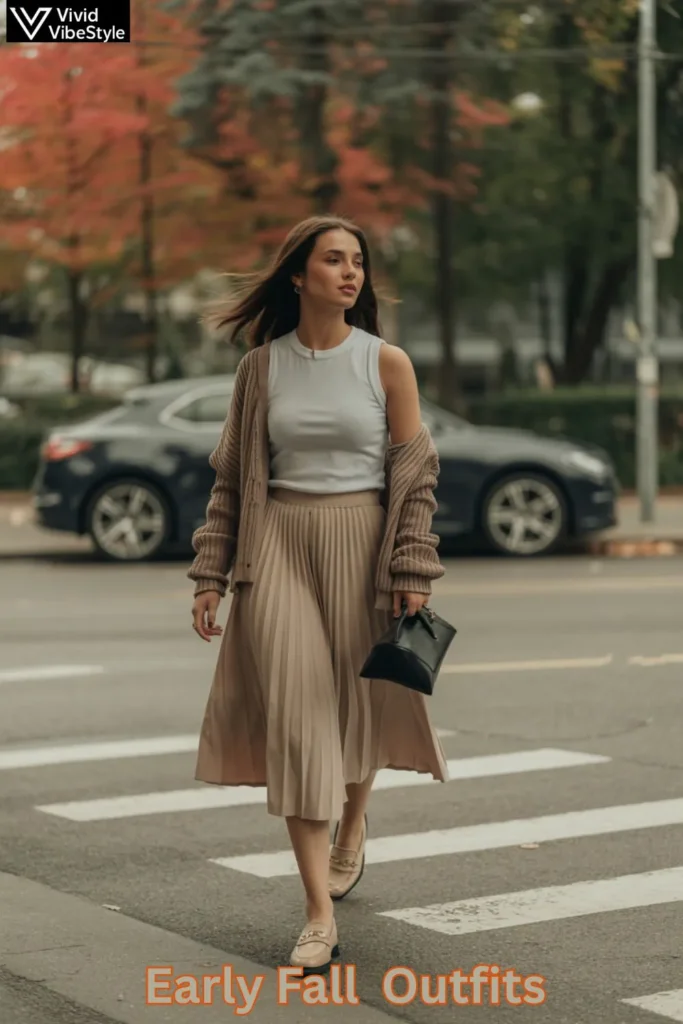
Many summer wardrobe staples translate beautifully into early fall outfits with strategic styling adjustments. Sleeveless blouses, lightweight dresses, and cotton shorts can all work for transitional weather when paired with appropriate layers and seasonal accessories that signal autumn awareness while accommodating warm temperatures.
The key to successfully incorporating summer pieces into early fall wardrobes lies in understanding how layering and accessory choices can completely transform an outfit’s seasonal appropriateness. A summer midi dress becomes early fall ready with the addition of a denim jacket, ankle boots, and autumn-toned accessories.
Read More About : White Summer Dresses: Your Ultimate Guide to Effortless Warm-Weather Style
Summer-to-Fall Piece Transition Strategies
“Denim, sneakers, and a plaid top or sweater it’s a simple combination that feels just right for September” demonstrates how basic summer pieces can be elevated with seasonal additions that create cohesive early fall looks without requiring entirely new wardrobes.
Lightweight summer cardigans and blazers become foundational pieces for transitional outfits when styled with early fall bottoms like darker wash jeans, midi skirts in autumn colors, or tailored trousers that provide visual weight appropriate for the changing season.
Frequently Asked Questions
What temperature range works best for early fall outfits?
Early fall outfits work best for temperatures ranging from 45-75°F, where layering strategies accommodate significant daily temperature fluctuations. This range typically covers September through mid-October in most temperate climates.
How many layers should I include in transitional weather outfits?
Successful transitional outfits typically include 3-4 removable layers: a base layer, middle layer, outer layer, and accessories like scarves that can be easily adjusted as temperatures change throughout the day.
Can I wear sandals with early fall outfits?
While closed-toe shoes better signal seasonal transition, stylish sandals can work in early fall outfits during particularly warm days, especially when balanced with autumn-appropriate colors and layering pieces.
What’s the biggest mistake people make with early fall styling?
The most common error is dressing for morning temperatures without considering afternoon heat, leading to overheating. Successful early fall outfits prioritize removable layers over heavy single pieces.
How do I know if my early fall outfit will work all day?
Test your layering outfits by considering each piece’s removal in reverse order—can you comfortable remove layers as temperatures rise while maintaining style and coverage throughout the day?
What fabrics should I avoid in early fall outfits?
Heavy wools, thick fleeces, and non-breathable synthetic materials often prove too warm for early fall outfits. Stick to natural fibers and lightweight blends that accommodate temperature variations.
Conclusion
Mastering early fall outfits transforms the challenging transitional season from a daily guessing game into an opportunity for creative, versatile styling. The key lies in understanding that successful transitional dressing prioritizes adaptable layering systems over rigid seasonal rules, allowing you to remain comfortable and stylish regardless of temperature fluctuations.
Strategic fabric choices, removable layers, and seasonal accessories create looks that work from morning coffee to evening dinner while signaling your fashion awareness throughout the autumn transition.
Early fall outfits represent the perfect intersection of practicality and style, proving that you don’t need an entirely new wardrobe to navigate transitional weather successfully. By incorporating breathable fabrics, mastering strategic layering techniques, and choosing versatile accessories, you’ll create a transitional wardrobe that adapts seamlessly to September and October’s unpredictable temperatures.
Embrace the season’s versatility and enjoy the creative possibilities that transitional outfits offer for expressing your personal style while staying comfortable throughout early autumn’s beautiful uncertainty.

